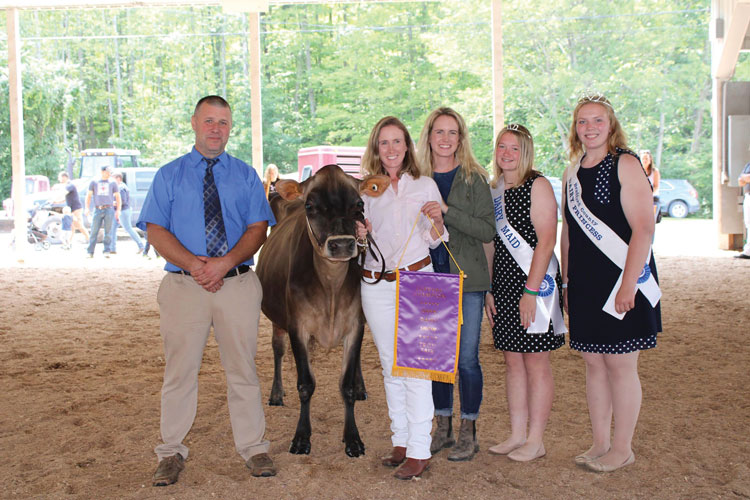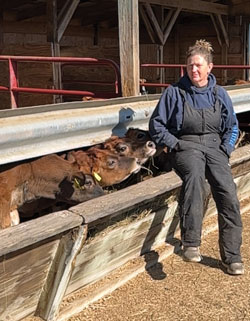Let’s face it, anyone who wants to be a dairy farmer may just be a tad unique. Why would one toil from sunup to sundown with loads of challenges, unknowns, and financial hurdles? Simply said, it is a concept the urban community cannot grasp.
Though the yearning is not gender specific, women have not always been encouraged to pursue careers as dairy farmers. However, that is changing. Women are increasingly at the helm of dairy farms as cultural expectations shift and opportunities grow.
Today, young ladies often outnumber young men in leadership roles of youth clubs, on teams that compete in dairy activities, and at the halter of cows in the showring. Of the 36 scholarships distributed by the National Dairy Shrine this year, 28 were awarded to young women. Those stats are surely representative and will firmly entrench the trend of women college graduates in agriculture now outpacing their male peers.
Three women who grew up on two dairy farms share their stories on managing a dairy herd, largely on their own, and the challenges of doing it as a woman. For all, the pursuit fulfills a burning desire to continue a legacy established by their families.
Always a farmer
For fifth-generation dairy farmer Tammie Stiles, sheer determination and the perfect setting have enabled her to manifest her dreams. Today, she milks 90 registered Jersey cows and continues the Skip-A-Rilla bloodlines developed by her family.
“As early as I can remember, I wanted to be a dairy farmer,” noted Tammie, who farms near Woodstock, Va. “From the time I was able to help bottle-feed calves, I knew this job was for me and that I would never be happy behind a desk.”

Resilience, tenacity, and timing have made that happen. In the early 1980s, when she was 15, her parents sold their farm in Virginia and the cattle, too. Tammie held back a few favorites and housed and milked them at other farms while she was in high school and earning her degree at Virginia Tech. She moved her milking string of 25 cows to a rented farm after graduation and then housed them at various locations over the years. They finally found their forever home in April 2019.
“When I walked onto this place, I immediately fell in love,” commented Tammie. “Though the facilities are older, they are well-maintained and laid out in a way that lets me handle cows and clean facilities by myself. At one point, they housed 300 Holsteins here, so it is spacious for my herd of Jerseys.”
Tammie rents the facilities and purchases grain from the farm’s owner, who charges a fair price and produces excellent quality feed. To help her manage the herd, she made a few facility changes. Maternity and sick pens were added, water troughs installed, and lighting improved.
Cows are milked in a double-six herringbone parlor and housed in a freestall barn with access to a 7-acre pasture. Calves are raised in polydomes until they are weaned and then moved to a calf barn, where they are grouped in 10 pens of three to four calves. After they are confirmed pregnant, they are moved to another barn and housed with far-off dry cows.
Tammie’s crew of volunteers includes her 19-year-old son, Trey, his friends, and this summer, a female intern from Virginia Tech. Tammie mates and breeds the cows on her own and relies heavily on software to manage the herd. Tammie has worked with cattle for decades, so she instinctively knows when an animal is sick or “off” and can diagnose many illnesses on her own and handle treatments with a text or phone call to the vet. Regular herd checks are administered by the veterinarian every six weeks, and other consultants include a nutritionist and accountant.

Like many women, Tammie says her biggest challenge has been maintaining equipment, a hurdle she is overcoming by learning what and whom to ask. “When I realized my problem was an emergency to me alone, I started asking, ‘Is this something I can fix and, if so, how do I do it and what do I need?’ I have learned enough of the basics that I can now fix much of my equipment with a phone call and a shipped part.”
Rewards for the long, sometimes lonely, days are pasture walks and bull talks with her dad, Clifford Stiles; cow talks with her sister, Amanda; chores with her sons; and good-natured competition with peers in the showring. Among the prize winners carrying their prefix is SAR Andre, Excellent-95, winner of the 2004 National Jersey Jug Futurity.
“This job is far deeper than milking cows for me. Seeing the sun rise and set on happy cows on pasture beats a desk job any day. And it is a big deal that the lineage of nearly every cow here traces to my dad’s original herd,” she said.
The sister act
Sisters Jamie and Shelby Crawford left the nest after school to pursue careers off the home farm, but they eventually found their way back to dairy with each other.
For Jamie, who earned a finance degree in 2008, her first calling was in banking. But eight years in, when she needed a mental break, she came home with the intent of returning to finance in a few months. Five years later, she is still at the farm.
Her baby sister, Shelby, graduated from high school in 2010 and then worked at a pair of powerhouse farms — Arethusa Farm in Litchfield, Conn., and Juniper Farm in Gray, Maine. Longing to be with family and her own cows, she returned to Pennsylvania two years ago.
The 188-acre Rome, Pa., farm near the Susquehanna River is home to 126 Holsteins and 41 Jerseys. Cows are housed and milked in a 71-cow tie stall barn. Feed is raised on 145 tillable acres. The Crawfords are in the process of purchasing an additional 200 acres so they can grow more forages.
Having grown up as a sisterhood of four, with no brothers and a father who passed away two decades ago, gender bias was not even in the lexicon when it came to chores. Jamie and Shelby learned how to work in the barn and the fields and are remarkably independent. They handle most of the data management, herd matings, milking, feeding, cleanup, and crop work on their own. Shelby is adept at diagnosing health issues, so she can usually treat cows without the assistance of a veterinarian.
The sisters get a hand with chores and equipment fixes from their beaus and other family members. A nutritionist balances rations and a veterinarian performs regular herd checks. An A.I. technician breeds cattle and handles embryo transfer and in vitro fertilization jobs.
To safely work with animals that can be 10 times their size, Jamie and Shelby are diligent about raising even-tempered, calm cattle.
“We don’t baby them, or halter break all of them,” said Shelby. “But we do get them used to being around people and comfortable being touched and moved from an early age. When we work with them, we are quiet and calm so they are quiet and calm. We have no issues bringing a first-calf heifer to her stall for the first time or moving cows in unfamiliar settings,” said the co-owner of Ho-Crawf Holsteins and Jerseys.
To supplement income, the Crawfords have developed a thriving market for high-end show cattle and lease cows as recipients for elite genetics from other breeders. They are becoming a familiar face, especially in Jersey circles, for their own homebred cattle and partnerships with other well-known breeders.
Among the most visible homebred animals is Ho-Crawf Andreas Joplin, Grand Champion of the 2021 All American Junior Jersey Show. Another standout is Drentex Velocity Glitterbug. She was purchased as a heifer calf and sold as a Very Good-89 (maximum score) milking yearling to South Mountain Jerseys, Boonsboro, Md., who showed her to blue ribbon laurels at The Jersey Event in July.
In the early years, Jamie also reaped rewards from some genomic investments, including a Holstein bull, Mer-James Tarnish, that sold to Sexing Technologies, and a Holstein female, Juniper-JLC Wish, that was struck off in the Bovines in South Beach Sale for $115,000 in 2018. That was part of their Mer-James Genetic enterprise.
“That success kept me motivated,” remarked Jamie. “But as the market shifted, we realized we are too small to be a viable player, so we pivoted to show cattle.”
For the sisters, motivation also comes from working together to continue a cattle breeding legacy established as Ho-Crawf. That’s the combination of the surnames of their mother, Sandra Hoag Crawford, and father, Merrill John Crawford. Meanwhile, Mer-James represents the first name of their father and his nickname for Jamie.
“Though Dad is no longer with us, he would be thrilled to see that we have figured out a way to stay in business,” Jamie continued. “He would also be proud to see we are doing it as a team.”










